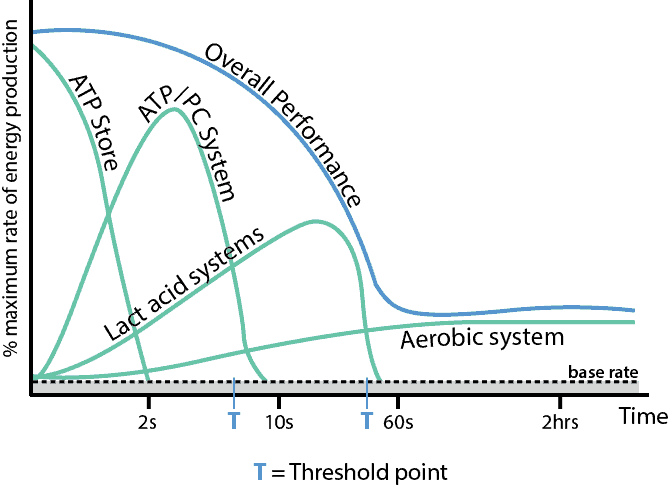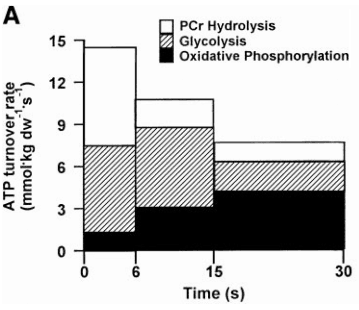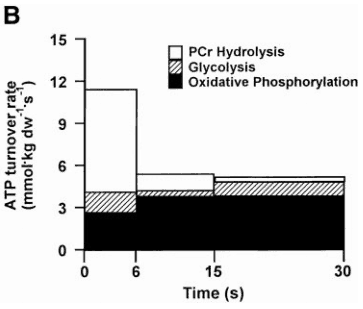I have seen this question arise several times; “Is Boxing an aerobic or anaerobic sport?”. I decided I wanted to dive into the research and see if I could find a definitive answer.
The simple answer is Yes, it is both. At any given time we have both Aerobic and Anaerobic pathways working at the same time. So, the better question might be is boxing predominately an Aerobic or Anaerobic sport? The answer seems to be pretty clear.
Energy System Overview

Aerobic Metabolism
The word aerobic has a Greek roots ‘aero’ meaning air and ‘bios’ meaning life. Aerobic metabolism requires oxygen to produce energy or ATP. The aerobic system is responsible for long term energy production.
The aerobic system is the only system that can utilize fats to create ATP and sugars. Because fats can be utilized for energy, the main limiting factors for aerobic energy production are:
- Cardio-respiratory system
- Oxygen usage by the muscles
- Substrate and enzyme availability.
The only byproducts of aerobic metabolism are CO2 and water.
The main limiting factor of the aerobic system is that it cannot produce energy as quickly as the anaerobic system. Therefore if energy demands exceed what the aerobic system can produce, the anaerobic system may play a larger role.
Anaerobic Metabolism
Your body has two anaerobic energy systems: Anaerobic Lactic System and the Anaerobic Alactic System. Both anaerobic systems can produce ATP at much faster rates than the aerobic system, however, that comes at the cost of fatiguing much more quickly.
Anaerobic Lactic System
The Anaerobic Lactic System can produce ATP more quickly than the aerobic system, however, cannot sustain that rate of energy production for much longer than 1 minute.
Anaerobic Alactic System
The anaerobic alactic system can produce energy in the range of 10-12 seconds before the system can no longer regenerate ATP for a period of time.
Energy Systems in Boxing
We know that the anaerobic alactic system can produce high amount of energy but only for 10-12 seconds, the lactic system can produce high amounts of energy for a little longer at close to 1 minute, and the aerobic system can produce moderate amounts of energy but can do so for much longer periods of time, like up to several hours.
Boxing matches rounds vary depending on age, gender, and level. a typical professional bout will be anywhere from 4-12 rounds of 3 minutes boxing and 1 minute rest in-between.
Evidence that Boxing is Predominately and Anaerobic sport
One study often cited, claiming boxing is 70-80% anaerobic is titled, Heart rate & blood lactate response in amateur competitive boxing by Ghosh AK et al. and Despite their claims, there are many limitations of the study.
- The 70-80% figure comes from heart rate and blood lactate measurements without expired gas measures.
- Lactate readings give a snap shot of what is happening at the moment however, may not tell the full story of what happened through a 2-3 minute round.
- Given reported lactate levels, (8.6, 9.5, 13.5 mmol/L, and that phosphocreatine replenishment rate of approximately 30-60 seconds it seems highly unlikely that the anaerobic system could be responsible for 80% of the energy of a 6 minute bout.
After reviewing energy systems and, understanding it takes roughly 30-60 seconds to replenish the phophocreatine stores, it seems highly unlikely that the anaerobic system could be the main energy producer in a professional or longer amateur boxing match given the length and duration of the bout.
Also, if the sport were truly an anaerobic sport you would expect high level boxers to have relatively good anaerobic testing compared to other high level athletes. However, that is not the case.

In the above article you can see that boxers do not have relatively high anaerobic power compared to athletes of other sports. In my opinion, it gives some insight, that having high anaerobic power in boxing is not a requirement to be successful.
Evidence that Boxing is Predominately an Aerobic Alactic sport
Boxing as a sport is an interplay between bouts of high intensity exchanges followed by lower intensity stretches. Boxing can almost be viewed as a sport of mini sprints followed by brief recoveries. It is important to be able to produce a lot of power while also keeping fatigue at a minimum.
An interesting study by Parolin et al., shows how the energy systems work during an initial maximal 30 second sprint.

You can see that initially the anaerobic system plays a much larger role in energy production. However, by 15 seconds the aerobic system is playing a much larger role.
In these repeated sprints they performed 3 maximal sprints with 4 minutes of rest in-between. Now 4 minutes does not constitute a full recovery after a maximal sprint, however, it is much longer than you get in a boxing match.

In contrast, you can see the difference after a 3rd sprint, in how the aerobic system plays a much larger role earlier in the sprint and throughout the duration of the repetition.
You can see that after the initial sprint the lactic system does not recover as quickly and play a significantly smaller role in the subsequent repetitions. However, the alactic system still plays a large role in the first 6 seconds of the last sprint.
Boxing after several rounds probably looks much more like the second graph with bouts of powerful movements fueled by the alactic system followed by lower intensity stretches and replenishment of the phosphocreatine system fueled by the aerobic system.
Direct Research Supporting that Boxing is an Aerobic Sport
One of the gold standards for measuring aerobic output during a sporting event is by measuring inspired and expired gases during performance of said sport. Boxing however, has several characteristics that make it impossible to measure gases during performance of the actual sport. The problem arises due to the fact you would need to wear a spirometric device to capture the gases which cannot be worn during boxing match due to risk of injury.
Davis et al. designed a study that had a work around so that gases could be measured while participating in a semi-contact boxing match while performing the same amount and types of movements found in an amateur boxing match.

The results in this study clearly demonstrate the the aerobic system provides the majority of the energy in a 3×2 minute bout. The findings were ***86% of energy came from aerobic sources, 10% alactic, and 4% from lactic sources.
As with any study there are limitations within the study, however, even with those limitations the evidence strongly supports that Boxing is predominately an Aerobic Alactic sport.
Just as in the previous study we see a decrease in use of the lactate system with each round and an increase in percentage of the aerobic system from the 1st to last round
Though the important moments in a fight (knockout punches or fight ending flurry) will most likely be attributed to the anaerobic system it is the aerobic system that refuels that alactic system and provides energy for the majority of the bout.
Correlation of Aerobic parameters and Boxing Rankings
Although correlation studies have their limitations, I think the the two following studies highlight that the aerobic system is crucial to performing at a high level in boxing. (Studies by Bruzas et al. & Guidetti et al. highlighting the correlation between aerobic capacity,sport mastery, and rankings in boxing.)
Sparring Data
I understand this is not peer reviewed data, however, I feel like it can provide some useful insight into the sport. In the Davis study we see that evidence that the lactic system plays a relatively small role in the energetics of a boxing match.

Here is an example of some heart rate data from sparring. Experienced fighters intuitively know the dangers of going too ‘deep into the well’ and not being able to recover during or between rounds. After reviewing heart rate data a lot of the fighters appear to be maintaining very close to their anaerobic threshold and only dipping past the anaerobic threshold occasionally as needed. Anecdotally, as a result, we can see fighters heart rates higher during simulated sparring than we do in actual sparring.
What Does it Matter?
The hope is by having a better understanding of energetics and a good understanding of physiology that coaches and athletes can create optimal training techniques and go into fights better prepared to handle the demands of the sport.
